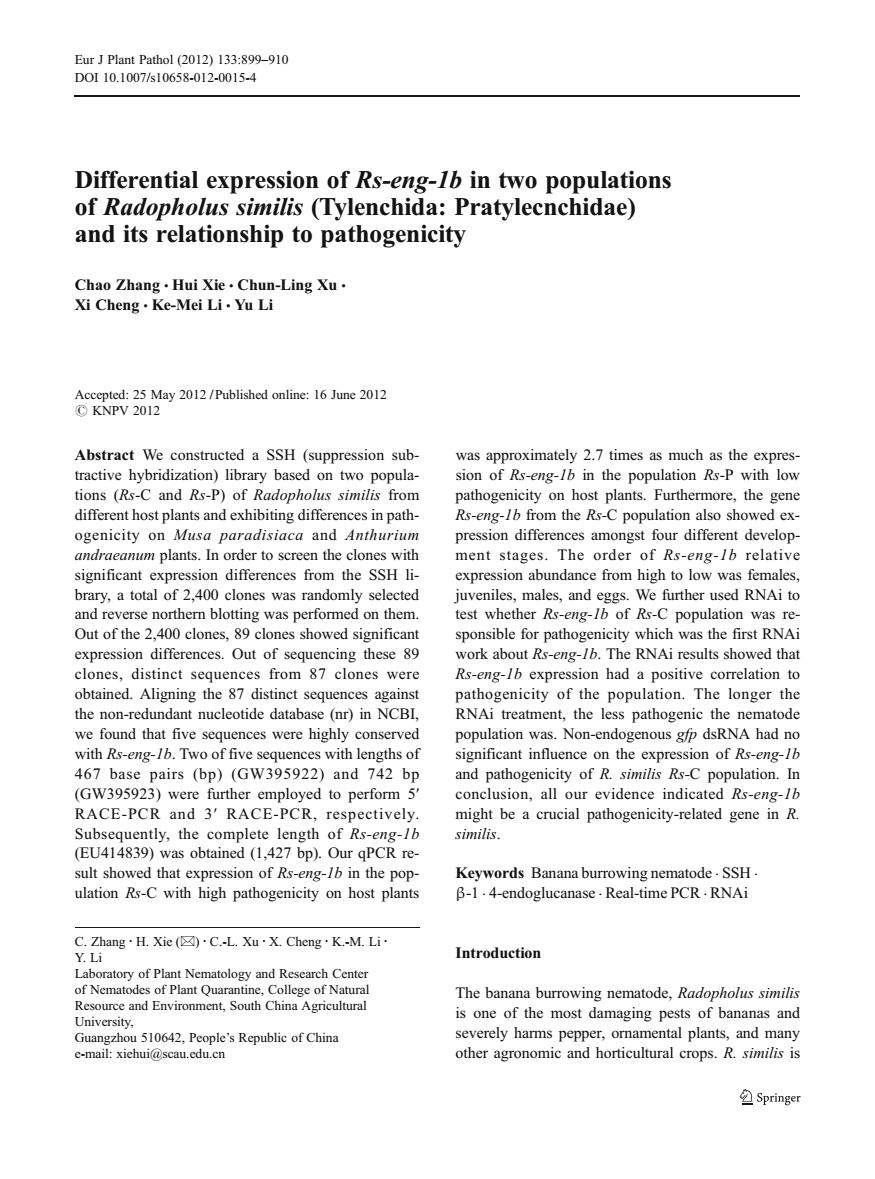正在加载图片...

Differential expression of Rs-eng-1b in two populations of Radopholus similis (Tylenchida:Pratylecnchidae) and its relationship to pathogenicity Chao Zhang.Hui Xie.Chun-Ling Xu Xi Cheng-Ke-Mei Li.Yu Li 825202omc161ac302 Abstract We constructed a ssh (suppression sub was approximately 2.7 times as much as the expre tractive hybridization)library based on two popula tions (Rs-C and Rs-P)of Radopholus similis from different host plants and exhibiting differences in path paradisiaca and Anthu from the R-Cpopulationw ogenicity on Musa nression differ es amo four different develor plants.In order to screen the clones with ment stages The order of Rs-eng-lb relativ significant ex ssion differences from the SSH li ssion abundance from high to lo was females ry.a total of 2400 clones was randomly selected iuveniles males and e We furthe used RNAi to and reverse northern blotting was performed on them test whether Rs Out of the 2,400 clones,89 clones showed significant sponsible for nathogenicity which was the first rnai expression differences.Out of sequencing these 89 work about Rs-eng-1b.The RNAi results showed that clones distinct sequences from 87 clones were Rs-eng-b exnression had a nositive correlation to obtained.Aligning the 87 distinct sequences against pathogenicity of the population.The longer the the non-redundant nucleotide database (nr)in nCBl RNAi treatment,the less pathogenic the nematode we found that five sequences were highly conserved population was.Non-endogenous gfp dsRNA had no with Rs-eng-/6.Two of five sequences with lengths of significant influence on the expression of Rs-eng-/b 467 base pairs (bp)(GW395922)and 742 bp and pathogenicity of R.similis Rs-C population.In (GW395923)were further emploved to perform 5 conclusion,all our evidence indicated Rs-eng-/b RACE-PCR and 3'RACE-PCR,respectively might be a crucial pathogenicity-related gene in R. Subsequently,the complete length of Rs-eng-/b similis (EU414839)was obtained (1,427 bp).Our qPCR re sult showed that expression of Rs-eng-Ib in the pop Keywords Banana burrowing nematode.SSH ulation Rs-C with high pathogenicity on host plants B-1.4-endoglucanase.Real-time PCRRNAi Introduction ratory of Plant Nematology and Research Cente The banana burrowing nematode,Radopholus similis is one of the most damaging pests of bananas and 510642.People's Republic of China severely harms pepper,omamental plants,and many -mail:xichui@scau.edu.cn other agronomic and horticultural crops.R.similis is Springe Differential expression of Rs-eng-1b in two populations of Radopholus similis (Tylenchida: Pratylecnchidae) and its relationship to pathogenicity Chao Zhang & Hui Xie & Chun-Ling Xu & Xi Cheng & Ke-Mei Li & Yu Li Accepted: 25 May 2012 / Published online: 16 June 2012 # KNPV 2012 Abstract We constructed a SSH (suppression subtractive hybridization) library based on two populations (Rs-C and Rs-P) of Radopholus similis from different host plants and exhibiting differences in pathogenicity on Musa paradisiaca and Anthurium andraeanum plants. In order to screen the clones with significant expression differences from the SSH library, a total of 2,400 clones was randomly selected and reverse northern blotting was performed on them. Out of the 2,400 clones, 89 clones showed significant expression differences. Out of sequencing these 89 clones, distinct sequences from 87 clones were obtained. Aligning the 87 distinct sequences against the non-redundant nucleotide database (nr) in NCBI, we found that five sequences were highly conserved with Rs-eng-1b. Two of five sequences with lengths of 467 base pairs (bp) (GW395922) and 742 bp (GW395923) were further employed to perform 5′ RACE-PCR and 3′ RACE-PCR, respectively. Subsequently, the complete length of Rs-eng-1b (EU414839) was obtained (1,427 bp). Our qPCR result showed that expression of Rs-eng-1b in the population Rs-C with high pathogenicity on host plants was approximately 2.7 times as much as the expression of Rs-eng-1b in the population Rs-P with low pathogenicity on host plants. Furthermore, the gene Rs-eng-1b from the Rs-C population also showed expression differences amongst four different development stages. The order of Rs-eng-1b relative expression abundance from high to low was females, juveniles, males, and eggs. We further used RNAi to test whether Rs-eng-1b of Rs-C population was responsible for pathogenicity which was the first RNAi work about Rs-eng-1b. The RNAi results showed that Rs-eng-1b expression had a positive correlation to pathogenicity of the population. The longer the RNAi treatment, the less pathogenic the nematode population was. Non-endogenous gfp dsRNA had no significant influence on the expression of Rs-eng-1b and pathogenicity of R. similis Rs-C population. In conclusion, all our evidence indicated Rs-eng-1b might be a crucial pathogenicity-related gene in R. similis. Keywords Banana burrowing nematode . SSH . β-1 . 4-endoglucanase . Real-time PCR . RNAi Introduction The banana burrowing nematode, Radopholus similis is one of the most damaging pests of bananas and severely harms pepper, ornamental plants, and many other agronomic and horticultural crops. R. similis is Eur J Plant Pathol (2012) 133:899–910 DOI 10.1007/s10658-012-0015-4 C. Zhang : H. Xie (*) : C.-L. Xu : X. Cheng : K.-M. Li : Y. Li Laboratory of Plant Nematology and Research Center of Nematodes of Plant Quarantine, College of Natural Resource and Environment, South China Agricultural University, Guangzhou 510642, People’s Republic of China e-mail: xiehui@scau.edu.cn